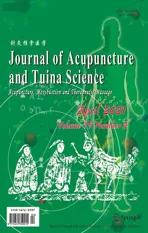Clinical observation on spleen-invigorating and qibenefiting pediatric massage for treating recurrent respiratory tract infection in children with cerebral palsy due to qi deficiency of spleen and lung
2021-04-23XieJieshan谢洁珊LiYuxiu李玉秀YanXiaolan严晓岚XunJingping荀静平JinBingxu金炳旭
Xie Jie-shan (谢洁珊), Li Yu-xiu (李玉秀), Yan Xiao-lan (严晓岚), Xun Jing-ping (荀静平), Jin Bing-xu (金炳旭)
Nanhai Maternity and Child Care Hospital Affiliated to Guangzhou University of Chinese Medicine, Foshan 528200, China
Abstract
Objective: To observe the clinical efficacy of spleen-invigorating and qi-benefiting pediatric massage (tuina) for treating recurrent respiratory tract infection in children with cerebral palsy due to qi deficiency of spleen and lung.
Methods: A total of 70 children with cerebral palsy who suffered from recurrent respiratory tract infection due to qi deficiency of spleen and lung were randomized into an observation group and a control group by the random number table method, with 35 cases in each group. Both groups were treated with conventional rehabilitation training, while the observation group was given additional spleen-invigorating and qi-benefiting pediatric massage, and the control group additionally took oral Yu Ping Feng granule. The clinical efficacy was evaluated by the total effective rate, traditional Chinese medicine (TCM) symptom score, and serum levels of immunoglobulin (Ig) A, IgM and IgG.
Results: The difference in total effective rate between the two groups after treatment was statistically significant (P<0.05).After treatment, the TCM symptom scores in both groups decreased to varying degrees than those before treatment,and the intra-group differences were statistically significant (all P<0.01); the differences in the scores of various TCM symptoms between the two groups were statistically significant (all P<0.05). After treatment, the levels of IgA, IgM and IgG of the children in both groups increased to varying degrees, and the intra-group differences were statistically significant (all P<0.05). The between-group differences in the IgA, IgM and IgG levels after treatment were statistically significant (all P<0.05).
Conclusion: Spleen-invigorating and qi-benefiting pediatric massage can effectively treat recurrent respiratory tract infection due to qi deficiency of spleen and lung in children with cerebral palsy, relieve the clinical symptoms and improve immune function, and thus is worthy of clinical promotion and application.
Keywords: Massage; Pediatric Massage (Tuina); Cerebral Palsy; Respiratory Tract Infections; Qi Deficiency of Spleen and Lung; Randomized Controlled Trials
Recurrent respiratory tract infection (RRTI) is a common respiratory disease in children from 6 months to 6 years old[1]. According to the survey report of World Health Organization, every ordinary child experiences about 4-8 times of acute respiratory tract infection per year, which seriously affects the physical and mental health of children due to the recurrence and lingering,bringing huge economic burden and mental pressure to
the family and society[2]. Children with cerebral palsy are more likely to develop RRTI because of multiple underlying diseases, poor physical constitution, low immunity, and long hospital stay[3]. Study reports showed that syndrome of qi deficiency of spleen and lung was the most common pattern in RRTI, accounting for 62.2% of all traditional Chinese medicine (TCM)syndrome patterns[4-6]. The diagnosis and treatment guidelines of RRTI in Chinese medicine list pediatric massage (tuina) as one of the main external treatment methods of TCM[7]. In this study, we observed the efficacy of spleen-invigorating and qi-benefiting pediatric massage in treating RRTI in children with cerebral palsy due to qi deficiency of spleen and lung. The report is as follows.
1 Clinical Materials
1.1 Diagnostic criteria
1.1.1 Diagnostic criteria for cerebral palsy
This study referred the diagnostic criteria in the Chinese Rehabilitation Guidelines for Cerebral Palsy(2015): Part 1[8].
1.1.2 Diagnostic criteria of RRTI
Diagnostic criteria of RRTI in Western medicine referred the criteria in the Clinical Concept and Management of Recurrent Respiratory Tract Infections in Children[9]. Diagnostic criteria in Chinese medicine referred the criteria in the Guidelines for the Diagnosis and Treatment of Traditional Chinese Medicine in Children with Repeated Respiratory Infections[7]. Primary manifestation: recurrent exogenous disease. Secondary manifestations: lusterless complexion, emaciated body status, flabby and strengthless muscles, weak and lazy to speak, shortness of breath, anorexia, no thirsty, profuse sweating, loose stools, a pale tongue with thin white coating, weak pulse, and thin superficial veins on index finger. Diagnosis of RRTI due to qi deficiency of spleen and lung could be confirmed when the primary manifestation plus four or more items of the secondary manifestations were met, with the tongue and pulse taken into consideration.
1.2 Inclusion criteria
Those who met the above diagnostic criteria; aged between 2 and 5 years old; with a duration over one year;with a remission over one week after the treatment of acute attack; whose parents were fully aware of the study process, and signed informed consent.
1.3 Exclusion criteria
Those with primary immune system diseases or severe heart, liver, kidney and hematopoietic system dysfunction; those with skin lesion, allergies or eczema at the treatment site; those routinely took immunomodulators more than one month within half a year; those who were unable to cooperate with pediatric massage treatment; those who were allergic to the medication used in this study.
1.4 Dropout criteria
Those who did not complete the trial and quit halfway;who did not finish the prescribed protocol or were continuously unable to receive the treatment for more than 10 d during the trial.
1.5 Statistical methods
All data were statistically analyzed by the SPSS version 21.0 statistical software. Measurement data were expressed as mean ± standard deviation (±s), and analyzed byt-test. Counting data were expressed as rate and processed by Chi-square test.P<0.05 was considered to indicate a statistically significant difference.
1.6 General data
A total of 70 hospitalized children with cerebral palsy due to qi deficiency of spleen and lung who met the diagnosis of RRTI were enrolled from the Rehabilitation Department of Nanhai Maternity and Child Care Hospital Affiliated to Guangzhou University of Chinese Medicine,between November 2018 and November 2019. All the children were randomly divided into an observation group and a control group by the random number table,with 35 cases in each group. During the trial, 7 cases dropped out, 3 from the observation group and 4 from the control group. A total of 63 cases completed the observation. There were no significant differences in gender, age and classification of cerebral palsy between the two groups before treatment (allP>0.05), indicating that the two groups were comparable (Table 1).
2 Treatment Methods
Children in both groups were treated with conventional rehabilitation training for cerebral palsy.
2.1 Observation group
The observation group was treated with additional spleen-invigorating and qi-benefiting pediatric massage.The selected points and manipulations referred the
Practice of Infantile Massage[10].

Table 1. Comparison of general data between the two groups
Kai-opening Tianmen: Pushed upward from the midpoint between the eyebrows to the front hairline alternately with the two thumbs for 36 times or 3-5 min(Figure 1).
Tui-pushing Kangong: Tui-pushed from the midpoint between the eyebrows to the sides with the finger pulp of thumbs for 30-50 times (Figure 2).
Rou-kneading Taiyang (EX-HN 5): Rou-kneaded Taiyang (EX-HN 5, at the depression at the end of the eyebrow) with the tip of the thumb or middle finger for 30-50 times (Figure 3).
Rou-kneading Erhougaogu: Anrou-pressed and kneaded Erhougaogu (at the depression below postauricular mastoid) with the tip of the thumb or middle finger for 30-50 times (Figure 4).
Rou-kneading Fengchi (GB 20): Anrou-pressed and kneaded bilateral Fengchi (GB 20) clockwise with both thumbs for 100 times (Figure 5).
Ca-scrubbing Feishu (BL 13): Ca-scrubbed back and forth between the two sides of Feishu (BL 13) with the hypothenar muscle of the palm until hot (Figure 6).
Fen-parting hand yin-yang: Separately Tui-pushed with both thumbs from Xiaotianxin to the lateral sides of the hand for 100-300 times (Figure 7).
Bu-reinforcing Pijing: Flexed the child’s thumb and Tuipushed from the tip of the thumb to the proximal finger crease of interphalangeal joint (Figure 8).
Bu-reinforcing Feijing: With the child’s finger pulp upward, Tui-pushed the child’s ring finger from the fingertip to the root for 100-500 times (Figure 9).
Bu-reinforcing Shenjing: Tui-pushed the child’s little finger from the fingertip to the root for 100-500 times(Figure 10).

Figure 1. Kai-opening Tianmen

Figure 2. Tui-pushing Kangong

Figure 3. Rou-kneadingTaiyang (EX-HN 5)
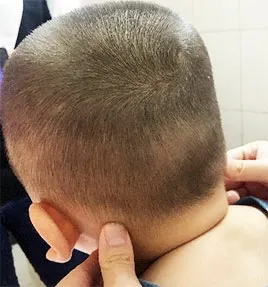
Figure 4. Rou-kneading Erhougaogu

Figure 5. Rou-kneading Fengchi (GB 20)
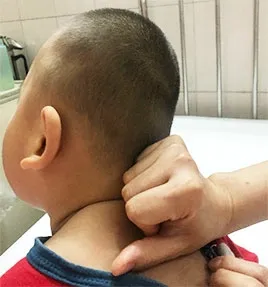
Figure 6. Ca-scrubbing Feishu (BL 13)

Figure 7. Fen-parting hand yin-yang

Figure 8. Bu-reinforcing Pijing

Figure 9. Bu-reinforcing Feijing

Figure 10. Bu-reinforcing Shenjing
Clockwise Yun-circular pushing Neibagua: The physician held the child’s four fingers with his left hand,making the child’s palm upward, and then circularly Tuipushed Neibagua clockwise with the lateral border of the right thumb for 50-100 times (Figure 11).
Tui-pushing Sihengwen: The physician transversely Cascrubbed back and forth along the finger crease of child’s four finger roots for 50-200 times (Figure 12).
Rou-kneading Banmen: Rou-kneaded the middle point of the thenar surface with the fingertip for 100-500 times (Figure 13).
目前我国正深化教育改革,着力培养素质全面发展的合格公民,从客观上要求加强和扩大中小学图书馆职能的发挥,而中小学图书馆给未成年人群体以适当的智识发展和精神发育上引导及文化熏陶就会成为其创建和发展的最大意义。由上述对教育学理论基础的回顾与阐释,可简单得出下列启示性的对策,希望对实际工作与理论研究都产生帮助作用。
Rou-kneaded Wailaogong with the tip of the thumb or middle finger for 2 min (Figure 14).
Nie-pinched the spine for 6 times (Figure 15).
The pediatric massage manipulations should be mild and gentle, steady and firm, and the strength should be tolerated by the child. The treatment was performed once a day, 6 times a week and one-day break afterwards.Three consecutive weeks constituted one treatment course, with a one-week interval between two courses,and a total of 3 courses were performed.
2.2 Control group
The control group was treated with oral Yu Ping Feng granule [State Food and Drug Administration (SFDA)Approval No.: Z10930036, Guangdong Medi-World Pharmaceutical Co., Ltd., China, 5 g/bag], 2.5 g per time,twice a day, with 3 weeks as a treatment course and a one-week interval between two courses. A total of 3 courses were taken.

Figure 11. Clockwise Yuncircular pushing Neibagua

Figure 12. Tui-pushing Sihengwen

Figure 13. Rou-kneading Banmen
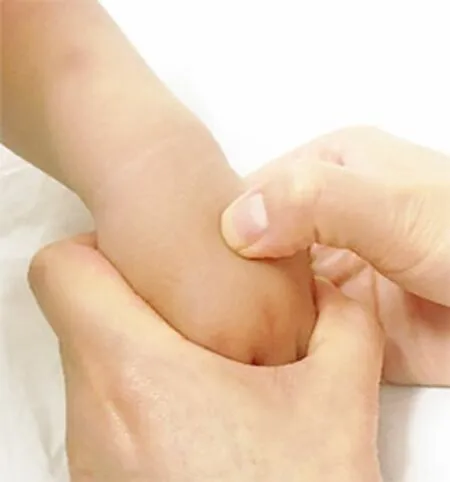
Figure 14. Rou-kneading Wailaogong
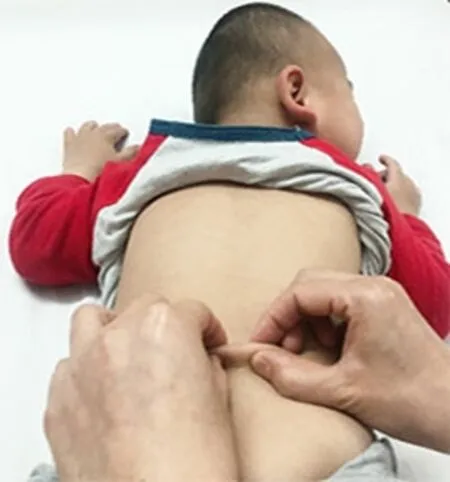
Figure 15. Nie-pinching the spine
3 Therapeutic Efficacy Observation
3.1 Observation items
3.1.1 TCM symptom scores and criteria of therapeutic efficacy
According to the Guideline on Evaluation of New Drug of Chinese Materia Medica for Treatment of Recurrent Respiratory Tract Infections in Children[11], the criteria of TCM symptom scores and therapeutic efficacy in this study were established. Through quantitative grading standards, the scoring scale for syndrome of qi deficiency of spleen and lung was established (Table 2). According to the severity of symptoms and signs, 0, 1, 2 and 3 points were scored for none, mild, moderate and severe,respectively. Among them, tongue and pulse conditions were used to assist syndrome differentiation, not scored.

Table 2. Syndrome of qi deficiency of lung and spleen scoring scale (point)
The reduction rate of TCM symptom scores was used as the criteria of efficacy evaluation. TCM symptom score reduction rate = (Total score of TCM symptom before treatment - Total score of TCM symptom after treatment) ÷ Total score of TCM symptom before treatment × 100%.
Clinically cured: The TCM symptom score reduction rate was ≥90%.
Markedly effective: The TCM symptom score reduction rate was ≥60%, but <90%.
Effective: The TCM symptom score reduction rate was ≥30%, but <60%.
Invalid: The TCM symptom score reduction rate was<30%.
3.1.2 Immune indicators
The serum immunoglobulin (Ig) G, IgA and IgM levels of both groups were measured before the first treatment and after the last treatment.
3.2 Results
3.2.1 Comparison of TCM symptom scores
There were no significant differences in the TCM symptom scores between the two groups before treatment (allP>0.05), indicating that the two groups were comparable. After treatment, the TCM symptom scores in both groups decreased to varying degrees compared with those before treatment, and the intragroup differences were statistically significant (allP<0.01). The comparison between the groups suggested that the differences were statistically significant (allP<0.05), (Table 3).
3.2.2 Comparison of clinical efficacy
After treatment, the total effective rate was 90.3% in the control group and 96.9% in the observation group,and the difference between the two groups was statistically significant (P<0.05), (Table 4).peripheral serum IgG, IgA and IgM levels in both groups increased to varying degrees compared with those before treatment, and the intra-group differences were statistically significant (allP<0.05), and the differences between the two groups were statistically significant (allP<0.05), (Table 5).
Table 3. Comparison of TCM symptom scores between the two groups before and after treatment ( ±s, point)

Table 3. Comparison of TCM symptom scores between the two groups before and after treatment ( ±s, point)
Note: BT=Before treatment; AT=After treatment; compared with the same group before treatment, 1) P<0.01; compared with the control group after treatment, 2) P<0.05
Group n Time Lusterless complexion Emaciated body status Weak and lazy to speak Shortness of breath food intake Anorexia Profuse sweating Reduced Loose stools Control 31 BT 2.74±0.45 1.58±0.23 0.97±0.24 0.91±0.30 1.56±0.67 1.51±0.60 3.22±1.10 1.40±0.77 AT 1.98±0.401) 1.01±0.201) 0.61±0.211) 0.79±0.251) 1.06±0.521) 1.04±0.441) 1.50±0.801) 0.77±0.321)Observation 32 BT 2.76±0.51 1.61±0.28 0.98±0.26 0.98±0.32 1.51±0.70 1.48±0.68 3.20±1.17 1.38±0.71 AT 1.71±0.491)2) 0.88±0.271)2) 0.48±0.191)2) 0.65±0.281)2) 0.78±0.491)2) 0.80±0.411)2) 1.02±0.731)2) 0.58±0.261)2)

Table 4. Comparison of total effective rate between the two groups after treatment (case)
Table 5. Comparison of peripheral serum immunoglobulins between the two groups before and after treatment ( ±s, g/L)

Table 5. Comparison of peripheral serum immunoglobulins between the two groups before and after treatment ( ±s, g/L)
Note: Compared with the same group before treatment, 1) P<0.01; compared with the control group after treatment, 2) P<0.05
Group n Time IgG IgA IgM Control 31 Before treatment 5.66±1.34 0.46±0.22 1.34±0.49 After treatment 6.32±1.281) 0.50±0.271) 1.38±0.431)Observation 32 Before treatment 5.78±1.45 0.47±0.25 1.36±0.47 After treatment 7.07±1.331)2) 0.62±0.181)2) 1.58±0.331)2)
3.2.3 Comparison of immune indicators
There were no significant differences in peripheral serum IgG, IgA and IgM levels between the two groups before treatment (allP>0.05), indicating that the two groups were comparable. After treatment, the
4 Discussion
Chinese medicine believes that RRTI is mostly caused by the deficiency of both lung and spleen, weak exterior defense, contracting the pathogens due to deficiency.Relevant study showed that deficiency syndrome accounted for 85.1% of children's RRTI, of which syndrome of qi deficiency of spleen and lung accounted for 62.2%[6]. In TCM, cerebral palsy falls under the category of ‘five retardations’, ‘five kinds of flaccidity’and ‘five kinds of stiffness’. Children with cerebral palsy are short of natural endowment and easily invaded by exogenous pathogens because of the disharmony between nutrient qi and defensive qi, insecurity of exterior defense and untight striae and interstice, which are caused by insufficiency of natural endowment and deficiency of kidney qi failing to store essence and transform qi. Spleen is the acquired foundation,governing transportation and transformation of the essence from water and food. The impaired transportation due to spleen deficiency causes the lack of source for qi and blood generation and transformation and results in the deficiency of healthy qi. Additionally,children’s spleen is usually insufficient, leading to milk and food stagnation which transforms into heat after long-term dyspepsia. The heat pathogen forces sweat out and transpired, which makes the striae and interstice open, making exogenous pathogens easy to take advantage and invade. The lung governs qi, skin and hair.The deficiency of lung causes weak exterior defense, and untight striae and interstice, resulting in the invasion of exogenous pathogens, and then leads to common cold,cough and dyspnea. In a word, the disorder of lung,spleen and kidney causes insecurity of Wei-defensive qi and decrease of resistance, and is the main cause of susceptibility to exogenous pathogen.
Study found that children with cerebral palsy were usually hospitalized for a long time for rehabilitation, and the risk of nosocomial infection increased by 1.014 times for every additional day of hospitalization[12]. Modern medicine believes that low immune function, lack of trace elements, and pathogenic microbial infections are the main causes of RRTI in children with cerebral palsy[13].Treatment of Western medicine for RRTI in acute stage is mainly based on anti-infection treatment, and supplement of vitamins and trace elements and immunomodulators medication are mainly used in remission stage[14-15]. Western medicine has a significant effect in treating acute RRTI, but the long-term effect of physical improvements is not obvious, resulting in the recurrence of disease, and the compliance of children and parents with long-term medication is poor. At present, in the treatment of RRTI in children, the external treatment of TCM is widely used exterior as the main treatment method in clinical practice[16]. Among them,pediatric massage can regulate Zang-fu organs, qi, blood,yin and yang, and unblock meridians and collaterals,thereby improving the functions of breathing and digestion, enhancing resistance, and effectively reducing the incidence of respiratory tract infections[17].
For children with the syndrome of qi deficiency of spleen and lung, prevention and treatment should be combined, and prevention is more important than treatment. The treatment method is to benefit qi and invigorate spleen, and invigorate lung for securing the exterior.
In this study, the treatment started with Kai-opening Tianmen, Tui-pushing Kangong, Rou-kneading Taiyang(EX-HN 5) and Rou-kneading Erhougaogu, namely the four manipulations for exogenous disease, which could unblock the meridians and collaterals, regulate qi and blood, and harmonize yin and yang. Wind pathogen is the primary cause of exogenous pathogen invading children, and Fengchi (GB 20) can accumulate the wind pathogen. Feishu (BL 13) is the perfusion point of lung qi.It is correlated with lung, and can regulate the meridian qi of lung. Therefore, Rou-kneading Fengchi (GB 20) and Ca-scrubbing Feishu (BL 13) until the skin turned reddish and local heat was generated in order to prevent wind pathogen, and to treat diseases of lung. Fen-parting hand yin-yang could harmonize yin and yang, as well as qi and blood. Spleen belongs to earth in five-element theory, while lung belongs to metal. Bu-reinforcing Pijing and Bu-reinforcing Feijing could fortify earth to generate metal. Strengthening spleen can invigorate lung, and assist transportation and transformation functions of spleen to transform and generate qi and blood. Bureinforcing Shenjing could treat debilitated constitution with congenital insufficiency, or due to long-term illness,and profuse sweating in children. Children’s spleen is usually insufficient, easily resulting in food stagnation that transforms into heat. Rou-kneading Banmen, Tuipushing Sihengwen and clockwise Yun-circular pushing Neibagua could regulate middle Jiao (energizer),harmonize qi and blood, and invigorate spleen and stomach, thus treating digestive tract diseases caused by transportation and transformation dysfunctions of spleen and stomach. Children with the syndrome of qi deficiency of spleen and lung have weak Wei-defense qi.Rou-kneading Wailaogong and Bu-reinforcing Shenjing could warm yang for dispelling cold and lifting yang qi, so as to enhance the function and effect of the exterior defense. Nie-pinching the spine was to lift and pinch from Changqiang (GV 1) to Dazhui (GV 14), which could activate meridian qi of the Governor Vessel, and regulate yin and yang. The combination manipulations of the above could invigorate and strengthen the lung, spleen and kidney, and improve immune function.
Yu Ping Feng granule is a famous traditional prescription in TCM for strengthening body resistance by consolidating the exterior. It comes fromShi Yi De Xiao Fang(Effective Formulas from Generations of Physicians)written by Wei Yi-lin, a physician in the Yuan Dynasty.Processed by modern technology, it has become a commonly used Chinese patent medicine for the treatment of RRTI in children. Multiple studies indicated that Yu Ping Feng granule had good curative effect in treating RRTI in children, significantly improving the immune function of the children and relieving clinical symptoms[18-21]. Therefore, we used oral Yu Ping Feng granule as the control. Results showed that the total effective rate of the observation group was superior to that of the control group, and the improvements of TCM symptom scores in the observation group were more significant than those in the control group (allP<0.05).Also, the increases of serum immunoglobulins (IgA, IgG,IgM) in the observation group were more significant than those in the control group (allP<0.05).
In summary, spleen-invigorating and qi-benefiting pediatric massage can effectively treat RRTI in children with cerebral palsy due to qi deficiency of spleen and lung, and improve immune function as well, with advantages of simpleness, convenience, effectiveness and no adverse reactions. It is easy to be accepted by children and parents, and worthy of clinical promotion and application.
Conflict of Interest
The authors declare that there is no potential conflict of interest in this article.
Statement of Informed Consent
Informed consent was obtained from the guardians of the recruited children in this study.
Received: 30 November 2019/Accepted: 11 May 2020
猜你喜欢
杂志排行
Journal of Acupuncture and Tuina Science的其它文章
- Review of systematic reviews of acupuncture for diabetic peripheral neuropathy
- Acupoint catgut-embedding therapy as promising treatment for non-alcoholic fatty liver disease
- Clinical observation of electroacupuncture with different frequencies for migraine without aura
- Warm needling moxibustion plus PKP for vertebral compression fracture due to kidney deficiency and blood stasis: a randomized controlled trial
- Evaluation of the prevention and treatment effects of acupuncture-moxibustion for Alzheimer disease based on various mouse models
- Effects of moxibustion on the P2X7R/STAT3/VEGF pathway in rats with colitis-associated colon cancer
